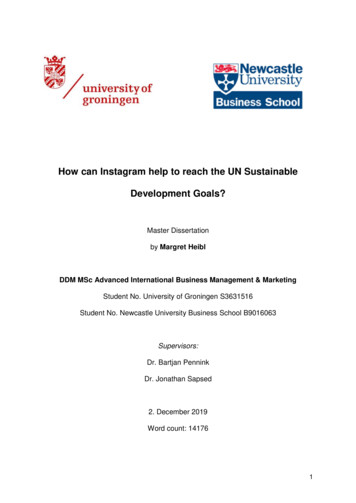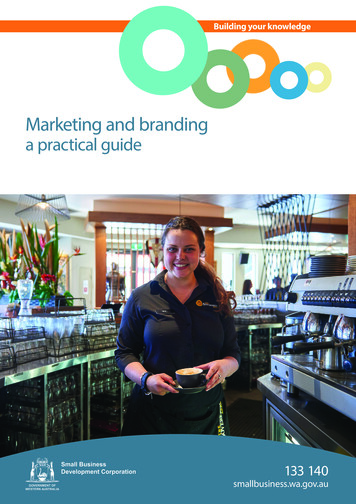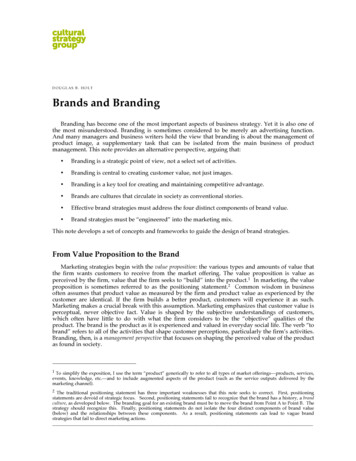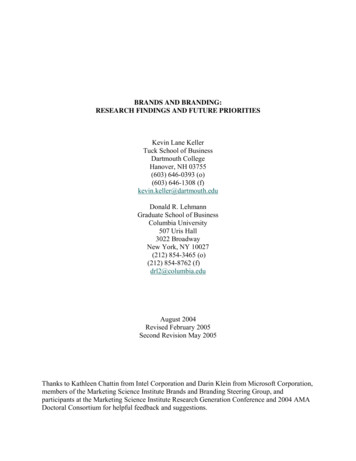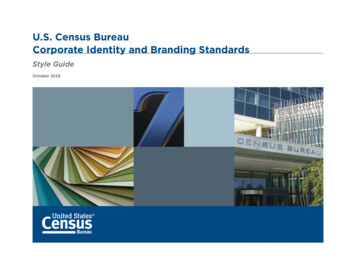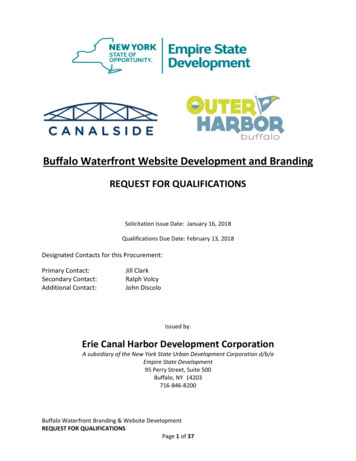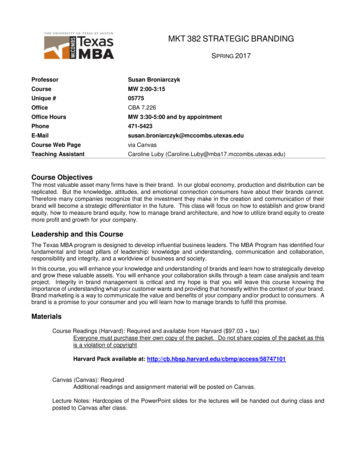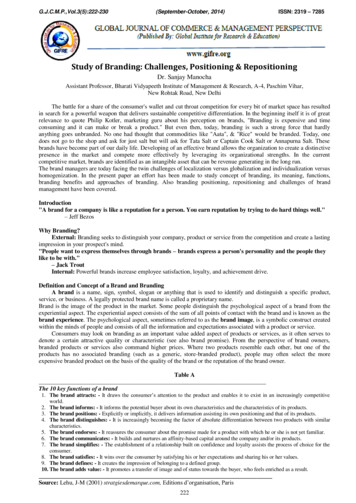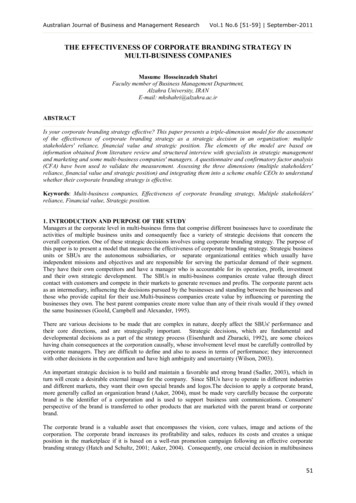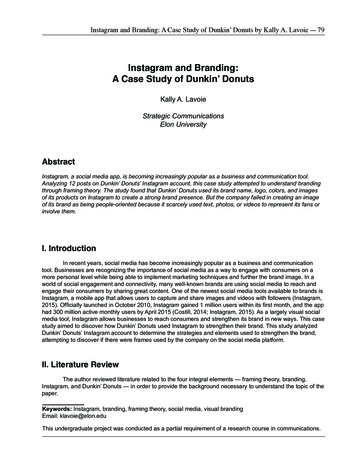
Transcription
Instagram and Branding: A Case Study of Dunkin’ Donuts by Kally A. Lavoie — 79Instagram and Branding:A Case Study of Dunkin’ DonutsKally A. LavoieStrategic CommunicationsElon UniversityAbstractInstagram, a social media app, is becoming increasingly popular as a business and communication tool.Analyzing 12 posts on Dunkin’ Donuts’ Instagram account, this case study attempted to understand brandingthrough framing theory. The study found that Dunkin’ Donuts used its brand name, logo, colors, and imagesof its products on Instagram to create a strong brand presence. But the company failed in creating an imageof its brand as being people-oriented because it scarcely used text, photos, or videos to represent its fans orinvolve them.I. IntroductionIn recent years, social media has become increasingly popular as a business and communicationtool. Businesses are recognizing the importance of social media as a way to engage with consumers on amore personal level while being able to implement marketing techniques and further the brand image. In aworld of social engagement and connectivity, many well-known brands are using social media to reach andengage their consumers by sharing great content. One of the newest social media tools available to brands isInstagram, a mobile app that allows users to capture and share images and videos with followers (Instagram,2015). Officially launched in October 2010, Instagram gained 1 million users within its first month, and the apphad 300 million active monthly users by April 2015 (Costill, 2014; Instagram, 2015). As a largely visual socialmedia tool, Instagram allows businesses to reach consumers and strengthen its brand in new ways. This casestudy aimed to discover how Dunkin’ Donuts used Instagram to strengthen their brand. This study analyzedDunkin’ Donuts’ Instagram account to determine the strategies and elements used to strengthen the brand,attempting to discover if there were frames used by the company on the social media platform.II. Literature ReviewThe author reviewed literature related to the four integral elements — framing theory, branding,Instagram, and Dunkin’ Donuts — in order to provide the background necessary to understand the topic of thepaper.Keywords: Instagram, branding, framing theory, social media, visual brandingEmail: klavoie@elon.eduThis undergraduate project was conducted as a partial requirement of a research course in communications.
80 — Elon Journal of Undergraduate Research in Communications, Vol. 6, No. 2 Fall 2015Framing TheoryThe purpose of this study was to discover if framing was at work in the company’s social mediastrategy by examining the branding of Dunkin’ Donuts using Instagram. Framing theory is based on theidea that “an issue can be viewed from a variety of perspectives and be construed as having implicationsfor multiple values or considerations” (Chong & Druckman, 2007, p.104). Chong and Druckman definedframing as “the process by which people develop a particular conceptualization of an issue or reorient theirthinking about an issue” (p. 104). In the field of communications, framing theory provides meaning to eventsor issues by organizing “everyday reality” (p. 105). The theory shows how mass communication influencesindividuals and the social world. One important aspect of framing theory is that it implies relationships amongthe elements of a message because a communicator organized the message (Baran & Davis, 1995). Framesare important in communications literature because they help researchers identify trends, compare mediacoverage, and examine the variations of messages across media (Chong & Druckman, 2007). Frames alsohelp communicators understand the way in which companies brand themselves. Understanding framing as arelationship among elements of a message relates to how companies brand themselves in traditional mediaand in social media.Framing has been used as a theoretical basis for many studies involving media and media effects.This type of literature has focused on framing in terms of how media present current events. De Vreese,Jochen, and Holli (2001) studied the framing of news surrounding the adaptation of the euro as a commonEuropean currency. By focusing on both media and audience frames, the researchers were able to determinethere were variations in media coverage of the event in different countries, with journalists more likely toemphasize conflict rather than framing it as political or economic news.Other framing research has been based around understanding the theory itself and its place inmedia research. Weaver (2007) discussed framing theory and its role in communication research. He foundthat framing studies were the most popular type of theory indexed by Communication Abstract from 1971 to2005, but were the most abstract. Future research, he concluded, should make an effort to define frames andframing more clearly to help conceptualize the theory.Researchers can examine variations framed in messages in small stories individually and understandthe meaning of issues throughout the stories. This means that framing can be analyzed to study branding onsocial media by looking at the variations of messages on social media to understand the brand as a whole.McClain (2011) used framing to understand branding in social media. Used framing theory to analyze theframing of news on Twitter, Wasike (2013) wrote, “In a broad sense, framing refers to the selection of certainaspects of reality in order to make them more salient in a bid to promote a desired interpretation” (p. 9). Thisidea shows that scholars can study the aspects that were chosen to appear on social media sites as explicitchoices with desired interpretations and uses to understand branding on Instagram.Another pertinent study of framing theory, which is related to advertising message construction, isthe Message Framing for Brand Communication model (Tsai, 2007). The model in Figure 1 shows that selfconstrual, consumer involvement and product knowledge are all factors that determine how effectively theframing of a message will influence attitude toward the advertising, the brand, and purchase intention.
Instagram and Branding: A Case Study of Dunkin’ Donuts by Kally A. Lavoie — 81Figure 1. Message Framing for Brand Communication (MFBC) Model, (Tsai, 2007, p. 365)Tsai (2007) proposed two main frames for advertising: positive and negative framing. Positive framingfocuses on the positive outcomes of the product brand, and negative framing focuses on moving away fromnegative outcomes of the product brand. Positive framing, for example, would exist in a meat product brandadvertised as 75 percent lean, while negative framing in the advertising would say 25 percent fat (p. 364) sothat consumers would be motivated to become active against a competitor’s brand.BrandingThe goal of branding is to create an emotional connection between a company and its consumers.Branding results from the sum of many different parts, including the brand name, logo, colors, and more. Itallows companies to differentiate themselves in an increasingly crowded market. The rise of new technologyis changing how companies communicate with consumers and in turn how they use branding.Research on building or maintaining strong brands available to communicators is considerable. Keller(2009), for example, studied new challenges for marketers when it comes to building and maintaining brands.The author proposes a customer-based brand equity model in order to address how brands can be built andmaintained through consumer knowledge structures. The model discusses a rational and emotional pathwaythat consumers may feel when becoming connected to brands. The pyramid model, in Figure 2, features thesix brand building blocks, brand salience, performance, imagery, judgments, feelings, and resonance (p. 143).According to the study, these building blocks are necessary to create a connection between a brand and aconsumer, in both a rational and emotional way.
82 — Elon Journal of Undergraduate Research in Communications, Vol. 6, No. 2 Fall 2015Figure 2. Customer-based brand equity model pyramid (Keller, 2009, p. 144)Other research studied the role of social media in branding. In “Social Media’s Role in Branding: A Studyof Social Media Use and the Cultivation of Brand Affect, Trust, and Loyalty,” North (2011) used cultivation theoryas a framework to check if social media impacted advertising outcomes. The research found that a correlationis present between social media use and brand trust and loyalty, linking social media and branding. This studysheds light on the importance and necessity for more research on brands’ presence on Instagram.Visual BrandingWhen studying Instagram, it is important to consider the visual aspect of the social media app.In a thesis titled “Get Schooled: A Visual Social Semiotic Analysis of Target’s Branding using Instagram,”Bevins (2014) used the theory of visual social semiotics to examine Target’s Instagram to “optimize [the]understanding of visual information” (p. 12). Although the Target study focused on one specific back-to-schoolcampaign, its research framework can be applied to the case study of Dunkin’ Donuts Instagram account.One theoretical perspective that this paper’s author adopted was Aaker’s Building Strong Brands Model forthe Brand Identity System, which emphasized four different aspects of brands, as shown in Figure 3.Figure 3. Aaker’s Building Strong Brands Model (Bevins, 2014, p. 19)
Instagram and Branding: A Case Study of Dunkin’ Donuts by Kally A. Lavoie — 83Brand as product, the first element of brand identity in Figure 3, represents the role of product inbuilding a consumer’s association with a brand. Brand as organization emphasizes businesses’ focusing ontheir organization’s attributes for branding instead of their product or service attributes. Brand as person alsohelps consumers relate to the brand personality. Symbols, the final element in the model, provide a visual tothe consumer and also drive the meaning behind the brand (Bevins, 2014).In order to establish a framework for analyzing the Dunkin’ Donuts Instagram images, the authorconsulted visual branding literature and created a list of elements that build a strong visual brand. A blog onHub Spot featured the “4 Ingredients of Social Media Success,” which can be used to strengthen brands’social media presence (Perkins, 2014). The most important tip for branding in this article was a consistentcolor palette: using the same colors over and over again, whether they are applied to the logo, text, orimages. Two to four colors were recommended to be used consistently throughout social media posts(Perkins, 2014). Another article from American Research Group, Inc. (2012) provided 10 rules for effectiveadvertising, which could be applied to social media use by brands. These 10 rules were phrased in the formof questions, such as “Does the ad use basic emotional appeals? Does the ad make the desired call to actiona part of the story? Does the ad use symbolic language and images that relate to the senses?”Next, a 2015 blog on WordStream.com created a list of 10 marketing tips to build a brand onInstagram, providing tangible, observable aspects. The first tip is to build community around an actionablehashtag. A hashtag is an important part of the Instagram experience. It allows users to find images related toa company of their interest and to tag and post their own user-generated content on Instagram. An actionablehashtag makes it easier for a brand to interact with its consumers. The second tip is to find the beauty inthe portrayal of a brand (da Cunha, 2015). The way in which a brand portrays its products can play animportant role in the branding process and may contribute to the framing of the brand on social media. Finally,Instagram itself offers advice for visual branding. On its company blog, Instagram recommends that its userscreatively use the app as a “Canvas for Seasonal Creativity” and upload various season- or holiday-relatedimages to the app. Businesses can embrace this idea for visual branding (“Instagram For Business,” 2014).Social Media/InstagramResearch on social media as a business and communication tool has seen significant growth in thepast decade. Much research has been conducted on the subject, including one discussed in the brandingliterature above, titled “Social Media’s Role in Branding: A Study of Social Media Use and the Cultivation ofBrand Affect, Trust, and Loyalty” (Bevins, 2014). The study examined whether or not social media was able toinfluence people’s brand perceptions. The results of the research indicated that a correlation existed betweensocial media use and brand loyalty, with age also playing a factor. The findings of this social media brandingresearch shows that there is, in fact, a link between social media use and branding.While there is much research about social media itself, Instagram research is still a new topic. Someresearch focused on Instagram as a social media tool. For example, a paper titled “How Instagram CanBe Used as a Tool in Social Network Marketing” discussed the ways in which Instagram can be utilized topromote brands and maintain relationships with customers. The research also examined how the platformwas favored among users as a largely visual medium in which consumers could interact with the brandsthey follow (Huey & Yazdanifard, 2014). Other Instagram research has focused on understanding whattype of content users upload on Instagram. For example, Hu, Manikonda, and Kambhampati (2014) studiedInstagram through an analysis of photo content and user types. They clustered a sample of 200 photosuploaded to the app by everyday users and created an eight category-coding scheme, against which photoswere analyzed for content. These categories included friends, food, gadget, captioned photo, pet, activity,selfie, and fashion. This study found what content users posted to
08.06.2017 · identity with a distinct pink and orange logo (Champagne & Iezzi, 2014). Dunkin’ Donuts’ communication strategy is heavily focused on the consumers and fans of the brand, encouraging them to tell stories and interact with the brand on social media.
